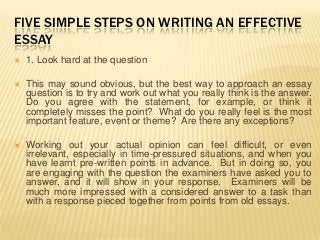
Five simple steps on writing an effective essay
- 1. FIVE SIMPLE STEPS ON WRITING AN EFFECTIVE ESSAY 1. Look hard at the question This may sound obvious, but the best way to approach an essay question is to try and work out what you really think is the answer. Do you agree with the statement, for example, or think it completely misses the point? What do you really feel is the most important feature, event or theme? Are there any exceptions? Working out your actual opinion can feel difficult, or even irrelevant, especially in time-pressured situations, and when you have learnt pre-written points in advance. But in doing so, you are engaging with the question the examiners have asked you to answer, and it will show in your response. Examiners will be much more impressed with a considered answer to a task than with a response pieced together from points from old essays.
- 2. 2. Plan Once you have identified your opinions on a question, you need to work out how you came to those opinions. The point of a plan is to set out the main lines of your argument, and a couple of choice examples for each point. The way you structure your plan is up to you, but many people find a spider diagram a useful tool. Each leg of the ‘spider’ should lead to one point, which will translate into one paragraph in your essay. These points should link to the examples which will provide evidence to back up your points. Clearly, when planning in an exam situation, your plans need only give a quick outline of these points and examples, but ten minutes spent on this will be an investment for an hour-long essay. To ensure that your essay is coherent and persuasive, make sure that all of your spider legs contribute to your overall argument. Work out which paragraph should go in which order – that way your argument is more likely to win over the reader.
- 3. 3. Structure your essay The plan will help immeasurably here, but you still can’t afford to take structure for granted. A good essay will have a strong introduction and an excellent conclusion. Since these are the first and last thing the reader will see, they need to work twice as hard to make your point. Clarity is the key here. Both your introduction and your conclusion should summarise your overall argument, and your main sources of evidence, without repeating each other. Each of the intervening paragraphs should make and attempt to prove a point, contributing to your overall argument. Your conclusion may also bring together your central lines of enquiry in a new way, which will help sustain interest. One example of this could be identifying which is the most important point that you have made, or showing how your argument fits into a wider discussion.
- 4. 4. Prove your points It is all very well to make grand claims about a book, topic or historical period, but a reader will probably want some evidence. Each paragraph should make a new point in support of your overall argument, and the whole paragraph should persuade the reader of that point’s merit. The simplest and clearest way to achieve this is by following this easy structure. Open each paragraph with a line summarising the point that you want to make. The next few lines should provide the proof: this might be in the form of a few choice facts, a quotation from your text, and / or a critical approach. It is not enough simply to insert this evidence and leave it up to the reader to work out what you mean. Try to analysis and evaluate your evidence: if it is a quotation, pick it apart; if a fact, contextualise it. Don’t be afraid to identify opposing opinions, or areas where the evidence is not so strong. A good argument incorporates these things, and becomes more nuanced as a result. Finally, bring the whole point together in your closing sentence. If you are doing this right, you should be able to read the first or last line of every paragraph and follow
- 5. 5. Interrogate the question (again!) A fail-safe way of ensuring an interesting and well thought out response is to keep on thinking about the question throughout your answer. Is there anything that the question fails to consider? Does the question itself represent a particular critical approach or even betray a form of prejudice? If the task includes a quotation, do you know anything about the person who said it that might add insight to your response? Sometimes, you might even be able to turn the question on its head. All of these approaches will make your essay exciting to read, and will give you an edge over other candidates who take the question at face value. The conclusion of your essay is often a good place to expand on any thoughts you might have of this type, but your consideration and reconsideration of the question should be evident throughout your piece.
